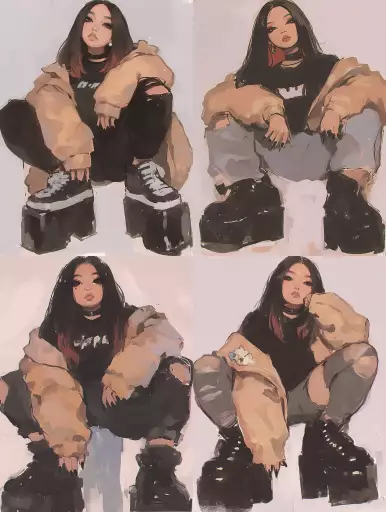Explore the Best AI Image Gallery

AI-Generated Images: Reimagining the Creative Landscape
The world of design is undergoing a seismic shift with the emergence of artificial intelligence (AI) capable of generating stunningly realistic images. This technology, powered by complex algorithms and vast datasets, allows designers to create visuals with unprecedented speed and efficiency. While this presents exciting possibilities for innovation and creative expression, it also raises important ethical considerations and prompts us to re-evaluate the role of human creativity in the design process.
A New Tool for Creative Expression
AI image generation tools offer a plethora of applications across various design disciplines. Illustrators can leverage these tools to quickly generate concepts, explore different styles, and iterate on their designs with ease. Graphic designers can utilize AI to create eye-catching visuals for marketing materials, websites, and social media. Architects and urban planners can experiment with different building layouts and cityscapes, visualizing their ideas in a more tangible way.
Furthermore, AI-generated images can be personalized and customized to meet specific client needs. Designers can input text prompts or sketches, guiding the AI to produce visuals that align with their vision. This opens up exciting possibilities for collaborative design, where humans and AI work together to bring creative concepts to life.
The Ethical Dimensions of AI-Generated Images
While the potential benefits of AI image generation are undeniable, it is crucial to address the ethical considerations that accompany this technology. One key concern is the issue of copyright and ownership. When an AI generates an image, who owns the rights to that creation? The developer of the AI tool, the user who provided the input, or the AI itself? This legal gray area requires careful consideration and may necessitate the development of new frameworks for intellectual property protection in the age of AI.
Another ethical concern is the potential for misuse. AI-generated images could be used to create deepfakes, which are synthetic media designed to deceive viewers. This technology can have harmful consequences, such as spreading misinformation or damaging someones reputation. It is essential to develop safeguards and ethical guidelines to prevent the malicious use of AI image generation.
The Future of Design in an AI-Driven World
As AI technology continues to evolve, its impact on the design industry will undoubtedly grow. We can expect to see even more sophisticated AI tools that enable designers to create complex and realistic visuals with greater ease. However, it is important to remember that AI should be viewed as a tool to augment human creativity, not replace it entirely.
The future of design lies in a collaborative partnership between humans and AI, where each brings unique strengths to the table. Humans will continue to provide the vision, creativity, and critical thinking, while AI will handle the technical tasks and generate innovative solutions. This synergy will lead to a new era of design that is more efficient, impactful, and transformative.
Conclusion
AI-generated images are poised to revolutionize the creative landscape, offering exciting possibilities for designers across various disciplines. While ethical considerations must be carefully addressed, the potential benefits of this technology are vast. By embracing AI as a tool for collaboration and innovation, we can unlock new frontiers in design and create a more visually rich and imaginative world.


















![**Representation: A dog acting as a private tutor to a child. The dog holds a ruler in its paw and stands at the blackboard to explain a dog diagram to the child. Graphic style: Line drawing, cartoon style, influenced by Franco-Belgian comics, thick black lines, simplified design, vector, black and white only, in the style of Keith Haring or the French comic strip "Alinéa". [IMPORTANT]: A single continuous line extending from one side of the image to the other, minimalist, strong outlines, line drawing, without lifting the hand, ultra-simplified, no shading, entirely white image, drawing created in the center of a sheet of paper. --ar 16:5** - Variations (Strong) by <@627984126871470085> (fast)](https://images.ai-img.art/thumbnails/150/f4e034998ccd869d8a061fd12017514fcd92210eb33d4222dc9b54716223f4dd.webp)







](https://images.ai-img.art/thumbnails/150/51c93500396faff4e7fa8b42bc68033067b16b2230e3496e95c482a581ff0fe9.webp)
![**Representation: A dog acting as a private tutor to a child. The dog holds a ruler in its paw and stands at the blackboard to explain a dog diagram to the child. Graphic style: Line drawing, cartoon style, influenced by Franco-Belgian comics, thick black lines, simplified design, vector, black and white only, in the style of Keith Haring or the French comic strip "Alinéa". [IMPORTANT]: A single continuous line extending from one side of the image to the other, minimalist, strong outlines, line drawing, without lifting the hand, ultra-simplified, no shading, entirely white image, drawing created in the center of a sheet of paper. --ar 16:5** - <@627984126871470085> (fast)](https://images.ai-img.art/thumbnails/150/7a854648a81e51241dcca8d24dd6e3bfcf07ad1df51baf401c9b729f4cf411fa.webp)







](https://images.ai-img.art/thumbnails/150/157712d76865d557120f9baf988de3d0525225295a2789c89bf2c4a5a96a03d1.webp)

![**Representation: A teenager smiling while thinking about a friendly dog, a comic-style thought bubble with a friendly dog inside. Graphic style: Line drawing, cartoon style, influenced by Franco-Belgian comics, thick black lines, simplified design, vector, black and white only, in the style of Keith Haring or the French comic strip "Alinéa". [IMPORTANT]: A single continuous line extending from one side of the image to the other, minimalist, strong outlines, line drawing, without lifting the hand, ultra-simplified, no shading, entirely white image, drawing created in the center of a sheet of paper. --ar 16:5** - <@627984126871470085> (fast)](https://images.ai-img.art/thumbnails/150/6fc850f638e3dee0c4b121acecad2c8419e02bdeac7f871d625f1003c1c3abe1.webp)


](https://images.ai-img.art/thumbnails/150/9d51c5e673b4f2068b7b01abc35425a06f173b76303adf9ad29ca14302c25b18.webp)



